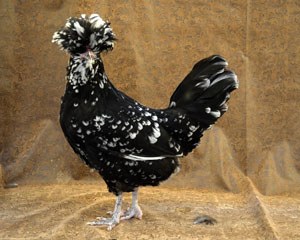Houdan Chickens
 The Houdan originated in France and were known even before 1700. It was found in a
town outside of Paris, Yvelines. The fowl are thought to be bred from breeds of that
area that have dated back to Roman times, AD 7 - AD 40. The Houdan were imported to
Great Britain around the 1850’s through the 1860’s. Then they were brought to the
United States in 1867 by Mr. Dorose.
The Houdan originated in France and were known even before 1700. It was found in a
town outside of Paris, Yvelines. The fowl are thought to be bred from breeds of that
area that have dated back to Roman times, AD 7 - AD 40. The Houdan were imported to
Great Britain around the 1850’s through the 1860’s. Then they were brought to the
United States in 1867 by Mr. Dorose.
Characteristics
Houdans possess a crest, beard and muffs and have five toes on each foot. Their rectangular bodies are set on fairly short legs. They are one of the better ornamental breeds for general utility use. Because of their crest, they require plenty of space and feed and water containers that prevent them from getting the crest wet and dirty, especially in cold weather. Because of the fifth toe, baby Houdans often walk with a skipping gait.
Standard Weights
Cock: 8 lbs
Hen: 6.5 lbs
Cockerel: 7 lbs
Pullet: 5.5 lbs
Varieties
- Mottled
- White
Skin Color
White.
Egg Shell Color
White.
Use
An ornamental fowl that is also a good egg producer and fairly good as a meat bird.
References
Chicken Breeds and Varieties (A2880), John L. Skinner, University of Wisconsin-Madison
Ekarius, Carol. "Chickens: Houdan." Pocketful of Poultry: Chickens, Ducks, Geese, Turkeys. North Adams, MA: Storey Pub., 2007. 80-81. Print.
"Houdan Chicken." The Livestock Conservancy. The Livestock Conservancy, n.d. Web. 29 June 2015.
Lewis, Celia. "Breed Profiles: Houdan." The Illustrated Guide to Chickens: How to Choose Them, How to Keep Them. New York: Skyhorse Pub., 2011. 93. Print.
